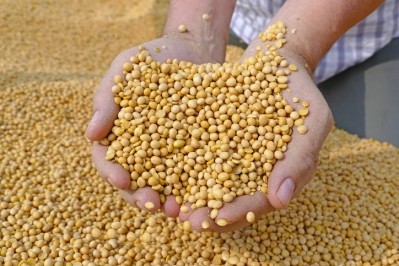USDA sees US soybean exports taking a hit from trade war

The US Department of Agriculture (USDA) released details of expected feed crop production and export markets for 2017/18 and the upcoming crop in a World Agricultural Supply and Demand Estimates (WASDE) report on Thursday.
For corn 2018/19 it will be about increased supplies, more feed and residual use, a boost in exports and smaller ending stocks, the USDA said. Expectations for soybeans are about smaller starting supplies in 2018/19, reduced exports, increased crush and larger ending stocks.
“Soybean exports [for 2018/19] are reduced 250 million bushels to 2.040 billion reflecting the impact of China’s import duties. Despite losing market share in China, soybean exports are supported in other markets as lower US prices increase demand and market share.”
Average prices for both feed crops, along with wheat, are anticipated to be lower, said the department.
Tariffs imposed on the US have had little effect on corn exports, said David Widmar, agricultural economist.
However, the predicted 250m-bushel drop in soybean exports and price is the “reality” of less trade with China.
“The longer this goes on the bigger and more severe it gets. Right now is generally not a time that we usually export a lot of soybeans – this is historically a slow time for soybeans .. so we’re in a grace period so to speak. We’ll really know what’s going on in December, January or early February of next year – that’s when China really turns to the US.”
However, there remains some uncertainty in the crop markets regarding trade and policy and how to resolve the current situation, he said. “The whole game is different now,” he added.
“In the last few years the conversation was where are soybean areas going to go – and it gave us a pretty good guiding light, but a lot of that has faded away,” said Widmar.
“You could paint the story that the farm economy is getting a little better and that we were starting to get back to a long-run stable situation,” he said. “If you look at the uncertainties, you start to see a bleak outlook – 2018 has an inflection point to it where we could look back in a few years and see this is where it started to get better or this is where our knees were knocked out from under us.”
Soybeans sales and shipments
Beginning stocks for US soybeans in 2018/19 have been dropped based on the increase in exports and crush during this marketing year, the USDA said. Production for next year is expected to be up 30m bushels to 4.3bn owing to the increase in harvested area.
Anticipated soybean crush has been increased to 45m bushels based on the expectation of growing domestic use of soybean meal and exports, the department said. Domestic soybean meal use was increased in consideration of lower meal prices and growth in livestock production.
“Soybean and product trade changes reflect the impact of China’s recently imposed soybean import duties in addition to other global oilseed supply and demand changes this month,” the USDA said. “US soybean meal exports are raised to offset reduced meal exports from South America where higher soybean exports displace crush.”
Exports were dropped by 250m bushels based on China’s import duties, the department said. However, there is a prediction that other markets will cover some of the market share lost from China.
Ending stocks for 2018/19 were increased by 195m bushels, the department said. The season average price range forecast for soybeans has been dropped to $8 to 10.50 a bushel and $315 to $355 a short ton.
Given current conditions, if no changes are made to the trade situation, soybean prices are likely to stay closer to the low end of the price range established, said Widmar. “I would typically say we’d be in the middle, but it’s a very binary situation,” he added.
“The upshot at this time of year is there isn’t a lot of trade activity, but the downside is there is no response we can do to limit production,” he said. If the tariffs and trade uncertainty continue there could be a longer-term effect on acres planted in other crops next year, which potentially could cause those prices to drop, he added.
The global supply for soybeans looks for increased production and a drop in trade and crush, the department said. Chinese tariffs on the US are expected to cause higher prices for soybeans in China, a drop in the growth of protein meal use, reduced crush and a decline in imports.
An expected 6.8m ton drop in exports for the US is forecast to be partially offset by an uptick in exports from Brazil, the department said. Brazil is predicted to see an increase in area planted in 2018/19 and higher prices.
Total global production for oilseeds was reduced 1.4m tons as an increase in soybean production is offset by a drop for rapeseed and sunflower, the department said.
Total global 2018/19 oilseed production is down 1.4 million tons to 592.6 million with a 4.3-million-ton increase for soybean production offset by lower rapeseed and sunflower.
Rapeseed production is reduced 2.6 million tons with lower production for the EU, Australia, Ukraine, and Russia. In the EU, rapeseed production is lowered for Germany and the UK on persistent dryness while production is lowered for France on pest pressure.
Sunflower seed production is down 2.9 million tons mainly for Russia and Ukraine on lower yields from dry conditions.
Corn sales and production
US corn beginning stocks were dropped by 75m bushels based on increased exports and use in 2017/18, the USDA said.
Exports of the feed grain in 2017/18 were strong and saw record-high shipments in May and continuing record sales, the department said. Feed and residual use were dropped based on indicated disappearance in the first three quarters of the marketing year.
Looking forward, the 2018/19 crop forecast was raised to 190m bushels, the USDA said. Projected feed and residual use have been increased by 75m bushels based on the larger crop and anticipated drop in the amount of corn used in ethanol.
Predicted exports saw a 125m bushel boost from the expected decline in competition from Argentina, Brazil and Russia, the department said. “With use rising more than supply, stocks are lowered 25m bushels to 1.552bn.”
However, the season average corn price was dropped to a range of $3.30 to $4.30 a bushel, the department said.
The international corn outlook for 2018/19 is expected to see lower production, trade and stocks, the department said.
Russia is predicted to see a smaller crop based on area planted and yield as drought conditions continue in the Southern and North Caucasus areas, the department said. Canada also is expected to have a smaller crop although production forecasts were increased for the EU.
In 2018/19 Russia is forecast to have reduced corn exports, which will be more than offset by the increased exports from the US, the department said. Anticipated imports were increased for South Korea and Saudi Arabia, but reduced for Japan and Mexico.
Additionally, corn production in Brazil for 2017/18 has been reduced, the department said. Corn exports for 2017/18 were lowered for both Brazil and Argentina and ending stocks were reduced.
Wheat, sorghum, oats and barley
Projected wheat supplies in the US for 2018/19 have increased by 74m bushels based on beginning stocks and production, the USDA said. Forecast production also was raised by 54m bushels.
Ending stocks for 2018/19 were increased by 39m, but remain 11% below last year’s stocks, the department said. The season-average farm price was lowered by $0.10 to a range of $4.50 to $5.50.
Internationally, wheat supplies for 2018/19 were reduced by 9.3m tons stemming from lower production in the EU from drought, along with Australia, Russia and Ukraine and a smaller area harvested in China.
Global wheat exports were reduced by 1.9m based on the smaller supply, the department said. Although Canada and the US are expected to see a slight increase in exports.
Total consumption also fell by 2.3m tons for food, feed and residual use, the department said. “With global supplies declining more than projected use, world ending stocks are reduced 5.3m tons to 260.9m,” it added.
Barley production has been increased in the US for 2018/19 based on improved yield and planted area, the department said. The forecast for sorghum production was raised based on the increase in planted area.
Barley production has been lowered for countries including Russia, Australia and the EU, but increased for Canada, the department said. Sorghum imports were reduced for China but are expected to be higher for Mexico and Japan.










